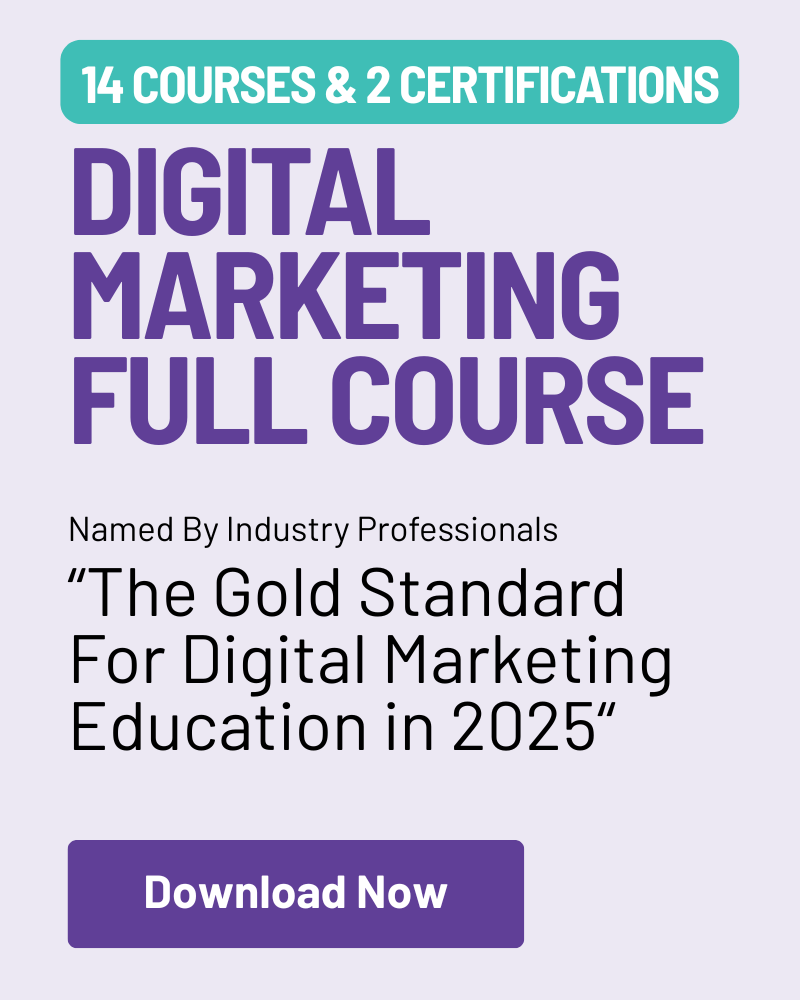- What Is Content Promotion?
- Strategy 1: Use Email Marketing
- Strategy 2: Share Your Content On Social Media
- Strategy 3: Strategically Mention Big Brands
- Strategy 4: Make Connections With Other Websites
- Strategy 5: Use Retargeting
- Strategy 6: Use Facebook Ads
- Strategy 7: Add New Content On Your Homepage
- Strategy 8: Promote Content With Internal Links
- Strategy 9: Use Guest Posting
- Strategy 10: Connect With Influencers
- Key Learnings
No matter how good your content is, you minimize your chances of getting positive returns if you don’t promote it to the right audience.
In this post, you'll learn effective content promotion strategies that work for any content. These are the same methods we use to drive thousands of visits to our website, and they have been proven to work repeatedly.
What Is Content Promotion?
Content promotion is the process of promoting blog posts and other content to reach a larger audience via digital marketing channels, such as email marketing, digital PR, paid ads, influencer marketing, and social media marketing.
The goal of content promotion is to drive traffic, engagement, and conversions by strategically placing your content where your target audience is most active.
Strategy 1: Use Email Marketing
The first method is to email your subscribers and inform them about your new content.
People subscribing to your list are likelier to engage with your content through social shares, comments, and links.
If this step does not apply to you because you don’t have an email list yet, then you are making a huge mistake. Email marketing applies to ALL kinds of businesses, and starting an email list is an essential first step.
If you already have an email list, follow these tips when sending out emails to promote your content.
- Keep your email short and to the point. Explain briefly how your subscribers can benefit by reading your post, watching your video, etc.
- Make it super easy for users to spot in the email the link/button to click to visit your site. Adding more than one way is proven to help (see screenshot below).
- Don’t hesitate to ask your subscribers to share your post on their social media channels. There is nothing wrong with reminding them about this.
Look at the screenshot below from the emails I send to my subscribers whenever I publish a new post.
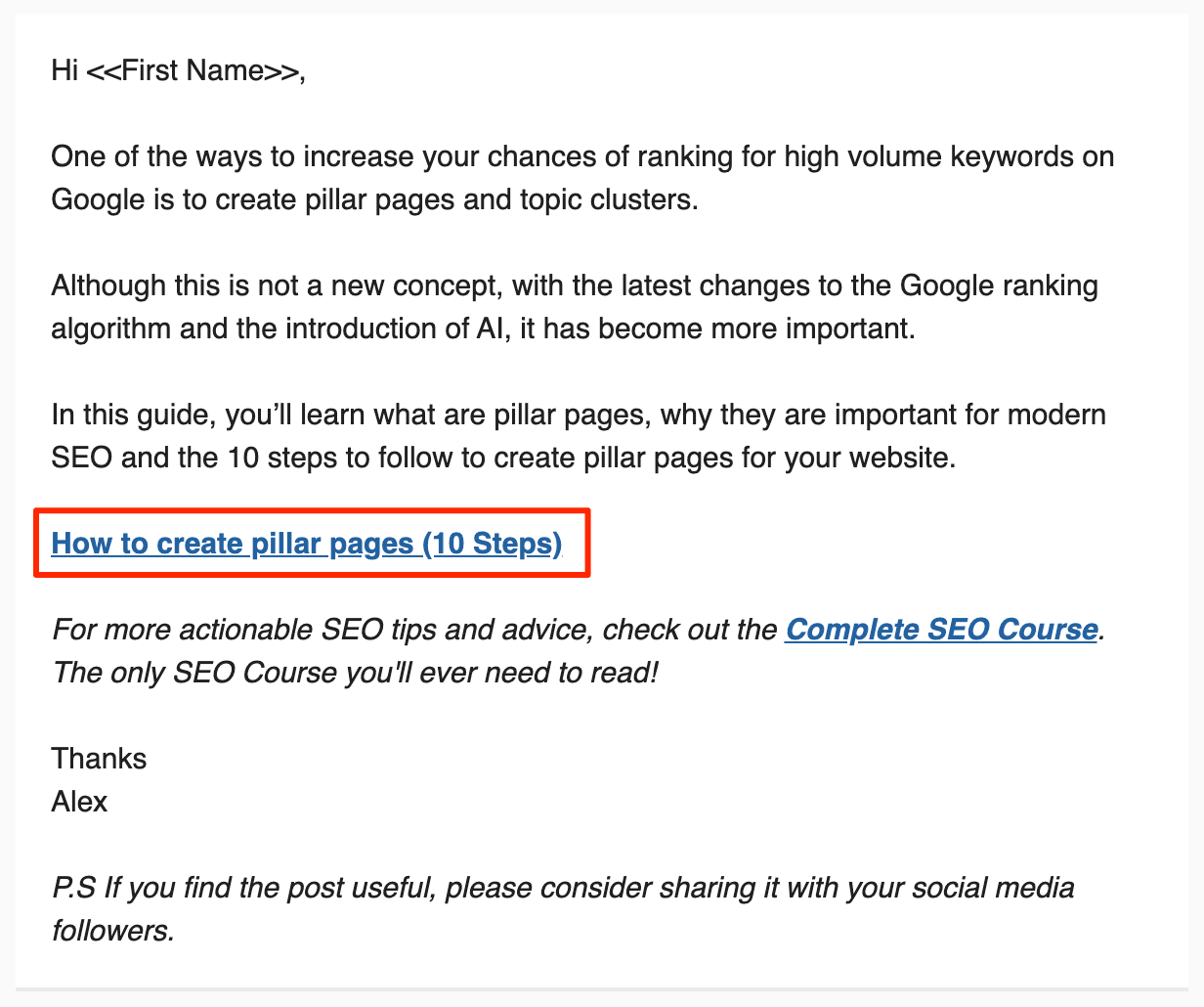
Strategy 2: Share Your Content On Social Media
Sharing your content on your social media networks has several benefits. While it is true that organic reach in all networks is decreasing over time, there are still some good reasons to go through this process.
The most important are:
- It’s a great way to keep your social media pages fresh with updated content
- Regularly posting to your social media pages helps them rank on the first page of Google for brand-related queries
- Before making a buying decision, people tend to check social media pages, and having updated content is much better than a desert island.
Here is the process to follow to promote your content on your social media pages:
- Publish to your Facebook business page.
- Share the post (from your business page) using your personal Facebook account.
- Share the post on Twitter multiple times. Use a social media scheduling tool like Buffer to create multiple tweets of the same post and schedule them to go live on different dates/times. This method has been proven to work great on Twitter.
- Make use of the correct number and type of hashtags
- Share the post on your LinkedIn network like you did with Facebook, i.e., add to your business page first and share the post using your personal account.
- Share the post on Instagram, Pinterest, and other social networks where you are active.
Strategy 3: Strategically Mention Big Brands
A great way to promote your content to a bigger audience (without paying) is to have other websites or companies promote it on their channels and audiences.
To achieve this, you must strategically mention or link to websites with social media influence in your content and then tag them on Facebook, Twitter, and Instagram to inform them about it.
This method is very easy to execute and can produce great results. Let me give you a real example to understand how this works:
In my Free SEO Courses post, I included a list of free courses from several reputable companies.
When the post was published, I added it to Twitter and tagged the companies mentioned. I then sent them a Twitter message informing them they were included in the post.
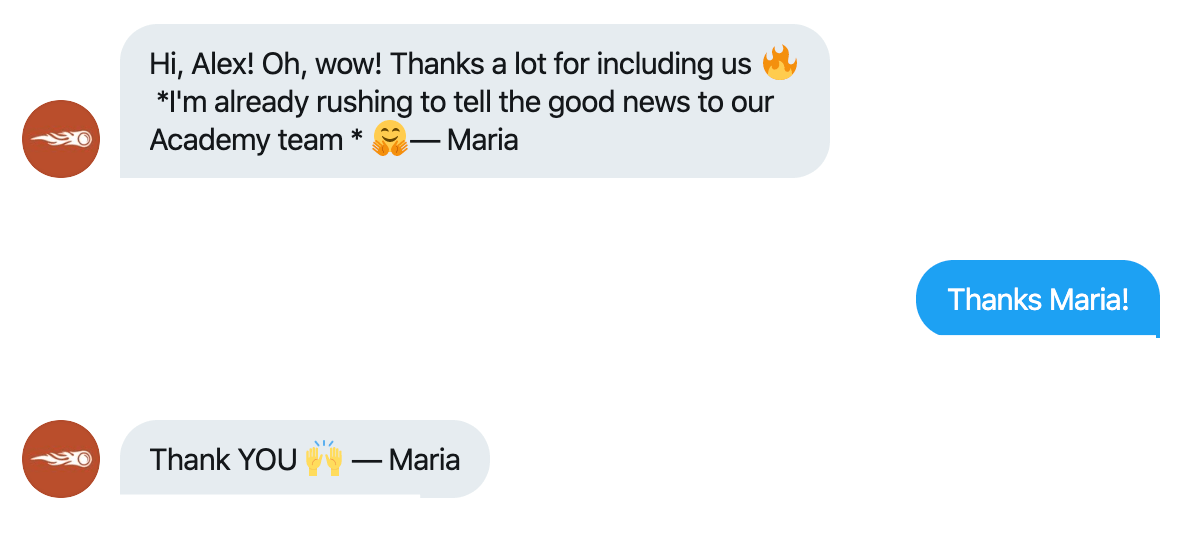
They, in turn, shared the post on their Twitter audience multiple times.

The post was re-tweeted and liked by many people, and the result was:
- More visits to my site.
- More people are following me on Twitter.
- More mentions of my brand on Twitter and other networks.
Strategy 4: Make Connections With Other Websites
This method is similar to the above, with the difference that instead of strategically linking to big companies, you link to other bloggers in your niche.
When researching to find content topic ideas, you’ll probably come across articles written by other bloggers who are the ‘influencers’ in your niche.
You can add a link to their articles, and once the post is published, email them to let them know about it.
You may have to research to find their contact details, but it is worth the effort.
Email them, letting them know that they acquired a natural link. I get similar emails and always reply with the same actions:
- Promote the post on my social media
- Follow the blogger on social media
- Add the blogger to my list of people to contact (more on this below in step 10)
- Visit their website and have it in mind when writing similar posts. If there is an opportunity, I will link them as well.
It turns out that other bloggers follow the same approach when you link out to them, and this not only helps to promote your current content but, over time, you’ll end up with a list of people who will be happy to promote your new content as well.
In addition, when influencers on social networks follow you, this increases your reputation and authority, something very important for building a brand and for SEO purposes.
Strategy 5: Use Retargeting
The next method is to promote your content to your EXISTING audience using Facebook retargeting ads.
Facebook offers several options for content promotion, and retargeting is one of the most effective in terms of post interactions and cost.
You can use retargeting to promote your content and pay as little as $0.10 per site visit, which is very low compared to what you normally pay for ‘boost post’ ads.
To be able to do that, you first need to set up your retargeting audiences on Facebook and, in particular, create custom audiences for:
- People who have already interacted with one of your previous ads
- People who have subscribed to your email list (there are ways to export your data from your email CRM to FB. If you’re using MailChimp, this is very easy to do).
- People who have visited your website before and have a FB account (you need to have the FB pixel installed on your website for this to work),
- People who have already purchased a product from your website.
Once you have your audiences ready, you can publish the post on your Facebook business page and use the ‘Boost Post’ feature to show the post ad to your retargeting audience.
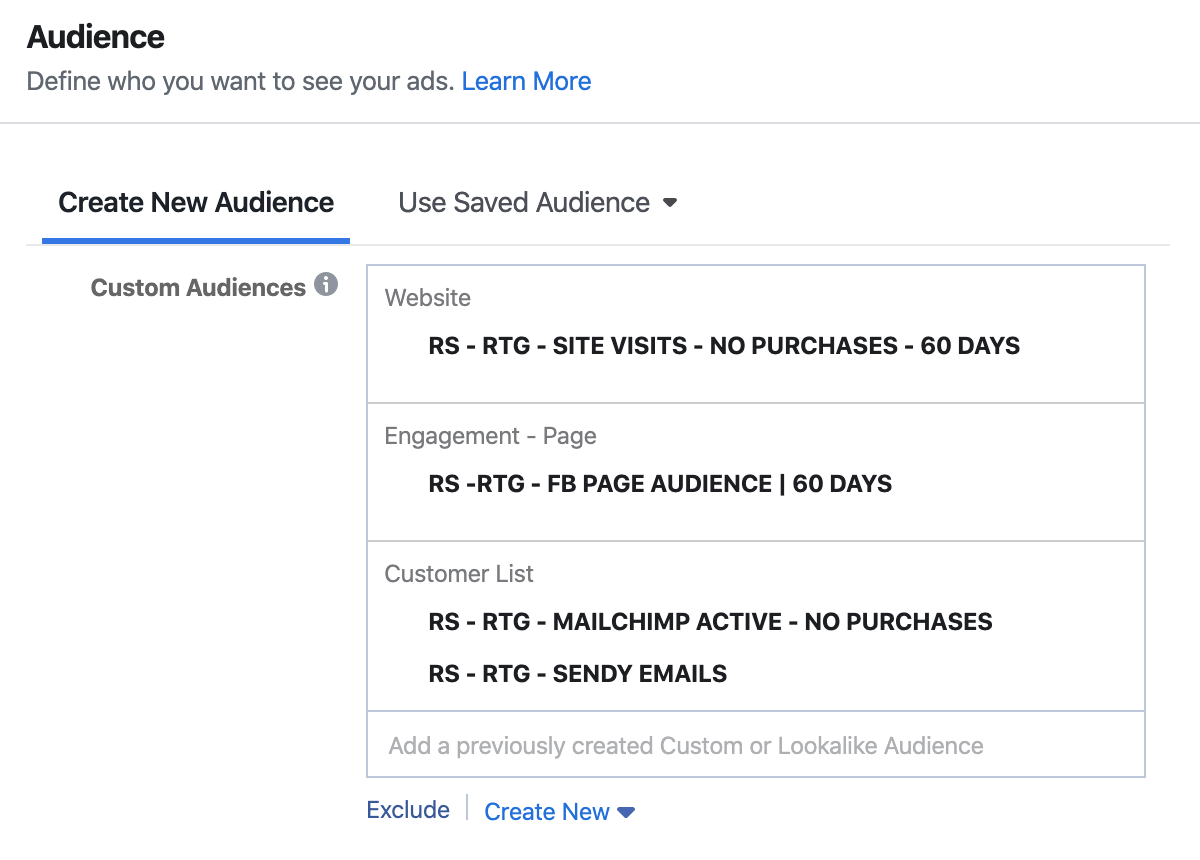
How much of your budget do you need to allocate for this? It depends on the size of your retargeting audience. You can start with a low budget of $50 and adjust it as you go along.
When you run your first retargeting campaign, you’ll notice that the number of post interactions (likes, shares, comments) and site visits will exceed your expectations. This is because your retargeting audience is people from your community who already know and trust your brand.
Strategy 6: Use Facebook Ads
Parallel to retargeting, you can also set up Facebook Ads to position your post in the FB feed of a new audience.
This method is not as effective (cost-wise) as the retargeting method, but you still have to do it because:
- It helps you promote your content to new audiences
- It enables you to grow your retargeting audience
- It’s a great way to make your brand known to more people
My recommendations to keep the costs low and increase the reach and effectiveness of your paid FB campaigns are:
Try different versions of your ad in the same campaign - Don’t use Facebook's ‘boost post’ feature, but create a new campaign and 2-3 ads targeting the same post but with different headings/wording.
Facebook will be ‘forced’ to test all ad variations and determine which ones perform better.
Narrow your audience as much as possible - When selecting the criteria for who will view your ads, try to narrow down your audience by adding several ‘interests’ to the filters.
Besides adding topics or demographic data, you can add competitor websites to the list and show your ads to people interested in your content.
Optimize your campaigns for landing page views and not interactions - When creating your Ad Set, select ‘Landing page views’ as the optimization method and not interactions. This way, you’ll pay FB when a visitor visits your website.
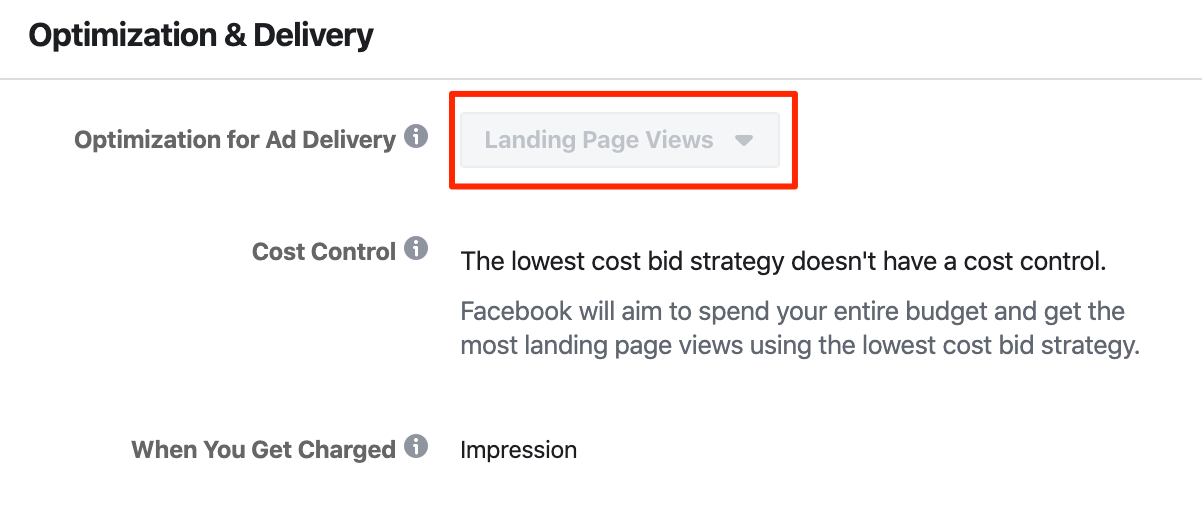
In terms of budget, start with a low budget, keep the campaigns running for a few days, and then analyze the results. If there is interaction with your ads, test more ad variations to find out the best combination of headlines/messages for the particular content.
You can also use Facebook's video ad studio to create short video ads for your posts easily and quickly. Compare the performance of video ads and image ads to find out which ones work best.
Strategy 7: Add New Content On Your Homepage
Once you’re done with the above methods, which are proven to work better than all the other methods, it is time to do some work to promote your content internally, i.e., on your website.
From my experience, this is a step many people ignore, but this is a big mistake, and I’ll explain why below.
When you publish new content, you need to:
Add a link from your homepage - You must do this for many reasons. First, a website's crawling starts from the homepage. Crawlers monitor and can quickly spot new links on the homepage, speeding up the time it takes to index your content.
Help direct visits find your content - If you already have traffic on your site and check your Google Analytics reports, you’ll notice that you have ‘Direct’ visits. These people visit your site to check for new content, and most of them (you can confirm this by looking at the ‘Landing Page’ report) land on your homepage.
Add a link to your main blog page.
This is normal for most websites, but if it’s not for your site, you must ensure that your new content also appears on the main blog page.
Add to your sidebar widget - If you use a sidebar on your site, adding a ‘Recent Posts’ widget to list your latest posts is good. To make it more appealing to the eye, you can add a NEW label to help users understand that the particular piece of content was published recently.
Strategy 8: Promote Content With Internal Links
The next step is broken down into two parts:
- First, find related articles on your site and add internal links to your new content.
- Second, find the high-authority pages of your site and link them to your new content.
Link to your new content from existing articles
An optimized internal link structure can help your SEO in many ways. It helps search engines and users find the content they need on your site.
When you publish a new post, go to Google and search for your site name + “keywords targeting in your post”.
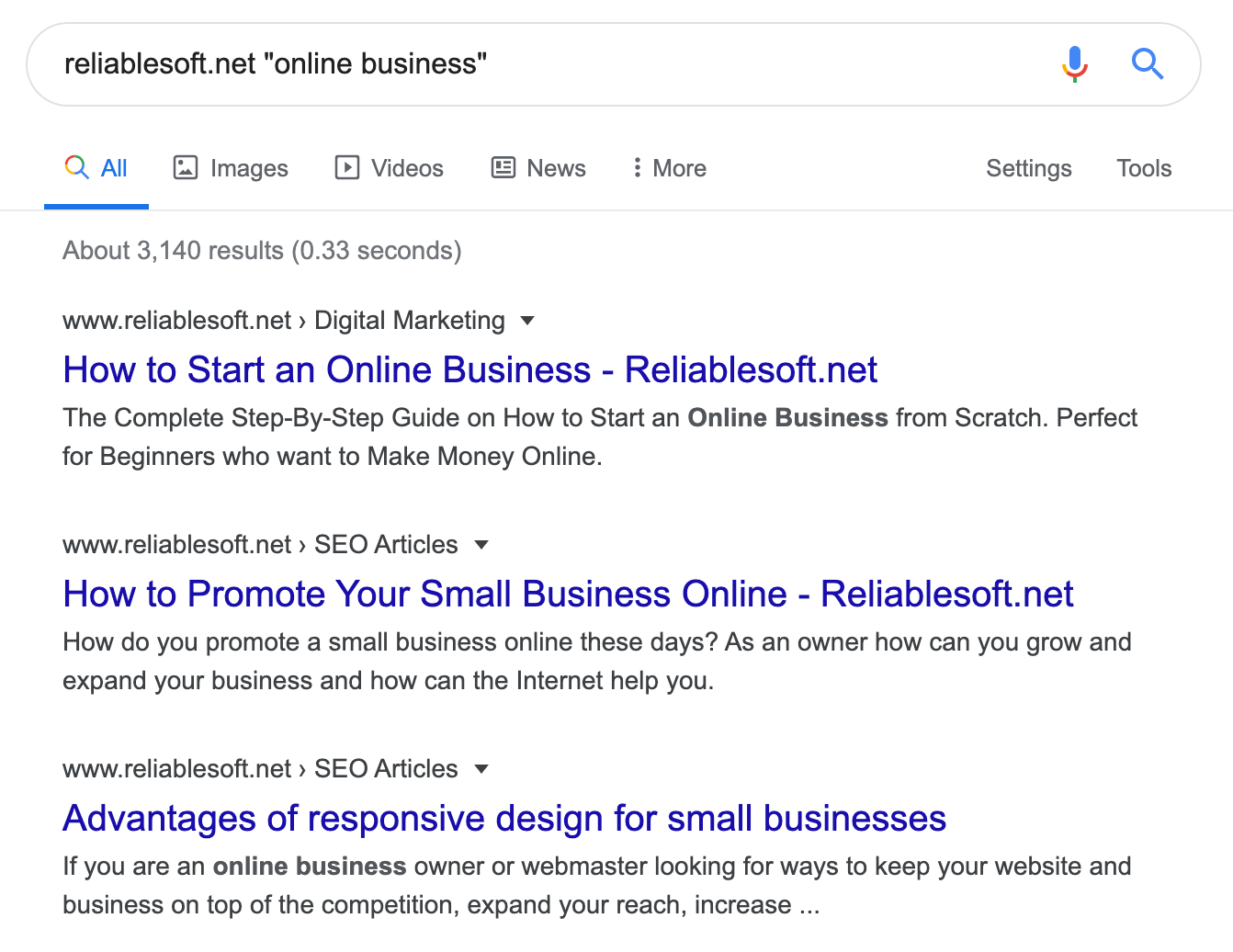
Google will show you a list of pages from your site related to the keywords you are targeting in the new post.
These are great candidates for adding internal links to your new post. You don’t need to add a lot of links. Aim to add at least 2-3 links for each post. If you have several posts that are highly relevant, there is no problem with adding more.
Link from high authority pages on your site
This step may not apply to all new content, so follow this if it’s relevant to your case.
Your site's high authority pages are those that already rank high on Google, get traffic from search engines, and have the greatest number of backlinks and social shares.
If any of these pages is closely related to the keywords you’re targeting in your new content, then by adding a link, you pass some of the page's authority (PageRank) to the new page, which will help it rank faster in the organic search results.
You can add the links using different methods; they don’t have to be in-line but can be added as a related source. Look at the example people and see how I linked to other site pages from my SEO checklist page.

Strategy 9: Use Guest Posting
I know in advance that this step will be followed by a very small percentage of content creators, but it’s a highly effective method of promoting your new content.
This step is more difficult than the other methods because you need to do some work and send a few emails to find websites on which to guest post and promote your work.
To make you feel better, if this step is too hard for you to follow, then don’t do it for every new piece of content you publish but for your best content.
Why are links important for content promotion?
For a page to rank on the first page of Google, it must have related backlinks from other websites.
If you have a website with a high domain authority and a lot of traffic, you won’t have to do this for all your posts because the domain authority will help them rank without links.
Also, if you already have a popular website, you will likely get natural links for new content without doing any extra work.
If your website doesn't meet the above criteria, you must actively pursue links to promote your content and help it rank in organic search results.
One of the best ways to do this is to get a link from a high authority-related website. The link has to be ‘dofollow’ to have any SEO value.
Methods 3 and 4 can eventually help you get links from high-quality websites, but another method is to post guest posts.
This is how the process works:
You find websites that you know accept guest posts. You can do this by searching Google using search terms like “ Write for Us, Contribute, Guest Author, Guest Post” or by visiting websites you know and looking at their footer or contacting us for links related to “Write for us”.
You then examine the website to find out what kind of guest posts they publish (what topics, type of content, length, etc.), read their guest post guidelines (if any), and apply to appear as a guest author.
In the submitted post, include a link to the content you want to promote.
Some tips to have in mind:
- Aim to guest blog on websites with higher Google trust and more traffic than your site. In other words, guests post on sites that can benefit you more than just a link.
- Check and ensure the links in the guest posts are 'dofollow'. If they have the 'nofollow tag', then they won't help your rankings.
- Include the links naturally in your post without keyword stuffing or over-optimizing the anchor text.
Strategy 10: Connect With Influencers
In step 4 above, I’ve mentioned that creating a list of influencers and people with whom you have already connected is very useful for content promotion, and I’ll explain why below.
When you make a one-to-one conversation (through email or Skype) with other bloggers in your industry, it’s like building business relationships. You both have common goals and can greatly help each other in many ways.
This differs from mass-emailing unknown contacts begging for links (a complete waste of time and often irritating method).
The best way to start a conversation with an influencer or another blogger is to give them value and then ask.
People are more likely to respond to an email informing them that they got a new link or social share rather than a general email sent to hundreds of people simultaneously.
Their initial reply starts the conversation; from that point, you can reply to them and discuss ways you can help each other.
Add these people to your ‘golden list of contacts’.
How to take advantage of your ‘golden list of contacts’?
When you have a great piece of content you would like to promote, you can contact the people on your list and ask them to help.
Because you already have a conversation with all of these people and have proven to them that you can actively help them with their content promotion, they will be more than willing to help you.
Just remember to make the emails personal to the recipient and your connection with them, not generic enough to look like they are being sent to a large number of people.
This process will require you to allocate some time, but it’s one of the best methods to promote your content, personal profile, and brand.
Key Learnings
Content promotion is not an optional process. It is one of the core processes of any content marketing campaign.
Creating good content is costly and time-consuming, and your goal should always be to promote your content in the best possible ways and maximize your returns.
Instead of wasting your time on unproven methods, create a simple content promotion plan and incorporate all the abovementioned methods. They are highly effective and have been proven to generate great results repeatedly.
